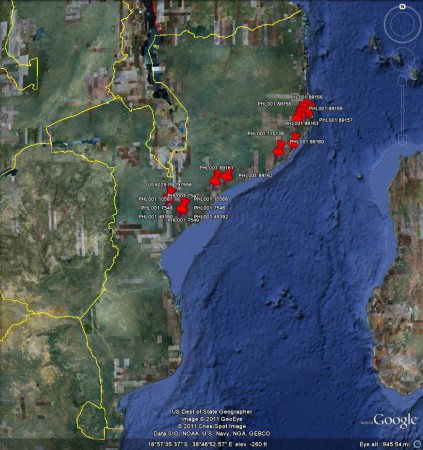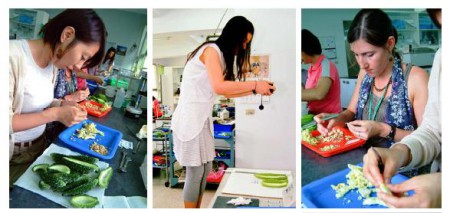- July issue of CSA News, official magazine for members of the American Society of Agronomy, Crop Science Society of America and Soil Science Society of America, has article on “Crop Adaptation to Climate Change” based on official CSSA position statement, “Crop Adaptation to Climate Change.”
- Factsheet on bacterial diversity and why it’s good for soils.
- FAO guidelines for the In Vivo Conservation of Animal Genetic Resources discussed in Europe.
- Please eat the daisies. Or other flowers.
- Farming chips.
- Never thought I’d get bored of reading about ancient beer.
Nibbles: Cranberry pests, Productivity, Resistance breeding, Jackfruit, Oca etc, Millets, Root crops, Semen cryo
- Guess what. Cranberry pests prefer certain varieties.
- If you can’t measure it, you can’t improve it. Estimating yield of food crops grown by smallholder farmers from IFPRI.
- CIAT first CG centre to publish peer-reviewed video, on resistance selection. In other news, there are peer-reviewed videos?
- CFTF draws our attention to Jackfruit – Forgotten Kalpavriksha, “a common trope”.
- $3.4 million worth of good news for food security and diversity in the Andes. “Small Andean tuber crops” involved.
- Minor millets star in new film shared by Bioversity.
- Want the Philippines to be self-sufficient in rice? Eat rootcrops. IRRI unavailable for comment.
- Way more than any sensible person will ever want to know about duck and goose semen.
The future of rice in Mozambique
Readers with long memories who had time on their hands back in January may remember a post we did then on IR80482-64-3-3-3, a new rice tailor-made for Mozambique. There was some discussion at the time about the claims being made in the original SciDevNet piece about the new variety on which we based our post, but what really struck me was this statement:
Work began when the International Rice Research Institute (IRRI), in the Philippines, sent Mozambique 11,200 rice varieties for testing.
That just sounded like quite a lot of varieties, and I remember wondering at the time how long it took the Mozambique national rice programme to get through that little lot. But anyway, I bring this up now not only because someone from IRRI has very kindly left a comment on the original post. But also because IR80482-64-3-3-3 is back in the news, cannily renamed Makassane. The IRRI press release has been widely picked up.
Following the approval of Makassane for release by the Mozambique Variety Release Committee earlier this month, IRRI provided government agencies and farmers “foundation seed” to use in bulking up the seed so that more can be produced and distributed to more farmers.
 Two things about this. First, I look forward to regular updates on Makassane’s uptake by farmers. And second, I hope the IRRI and Mozambique national genebanks are confident that they already have good representation of the local landraces. Sophie, who left the aforementioned comment, says there are 76 rice types from Mozambique at IRRI. Genesys gives us just over 120 worldwide, between landraces and wild species, but only a few are geo-referenced (see map).
Two things about this. First, I look forward to regular updates on Makassane’s uptake by farmers. And second, I hope the IRRI and Mozambique national genebanks are confident that they already have good representation of the local landraces. Sophie, who left the aforementioned comment, says there are 76 rice types from Mozambique at IRRI. Genesys gives us just over 120 worldwide, between landraces and wild species, but only a few are geo-referenced (see map).
Nibbles: Median strips, Vitamin A, Mapping in Kenya, Chaffey, Small farms, Rennell Island coconuts, Sweet potato breeding, Acacia nomenclature, Crop models, Pulque, Fruits
- Planting roadsides with natives, including crop wild relatives. And here comes the database.
- Orange Maize: The Movies.
- VirtualKenya really here. Mother-in-law beside herself.
- Plant Cuttings is out. And all of a sudden I’m in a much better place.
- Small is beautiful, farm edition. And as chance would have it, coffee farm edition. And urban edition.
- Dispute at iconic coconut plantation resolved. Apparently there are some really unique varieties there.
- I say boniato. For the first and last time.
- Acacia on the brink. Easy, tiger. The name, not the genus.
- We’re going to need a better model.
- Pulque comes back. Never knew it had gone away.
- Domesticating fruit trees in Kenya. Something for VirtualKenya?
Making the most of bitter gourd diversity at AVRDC
Another interesting agrobiodiversity piece in AVRDC’s newletter today:
The AVRDC Nutrition group is locked in a struggle with a cucurbit – and so far, warty Momordica charantia appears to be winning! As part of the project “A better bitter gourd: exploiting bitter gourd to increase incomes, manage type 2 diabetes, and promote health in developing countries,” researchers have begun preparing samples of the vegetable for later laboratory analysis.

Interested? “Like” the project’s Facebook page then!